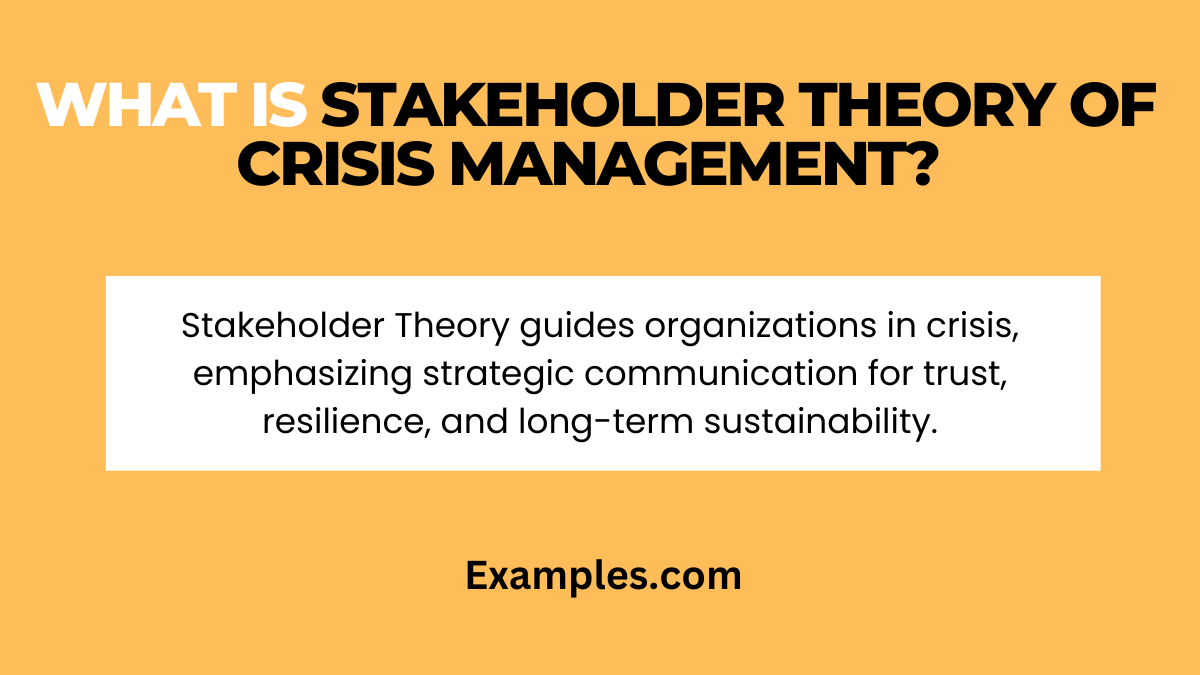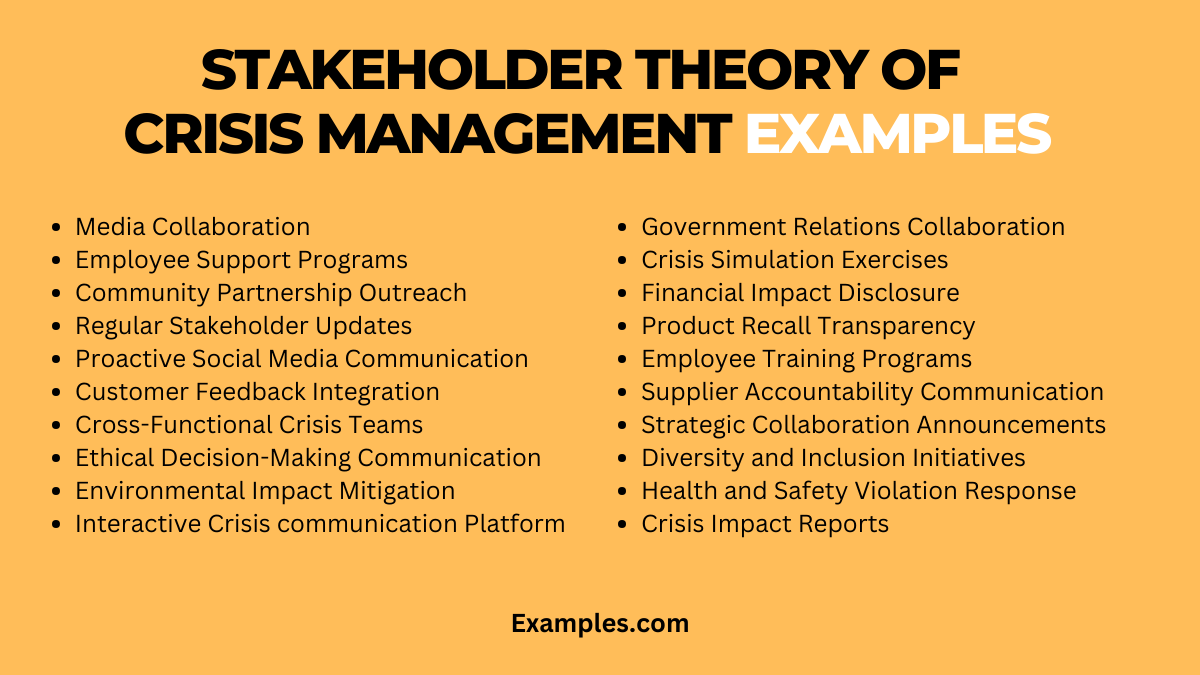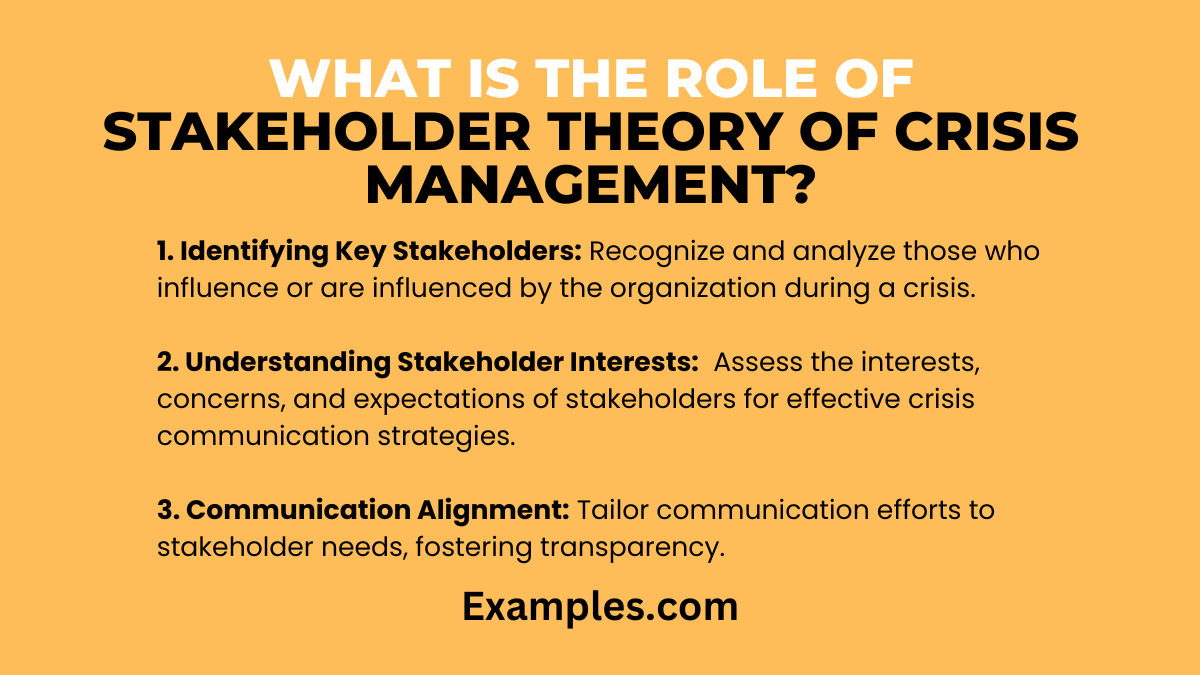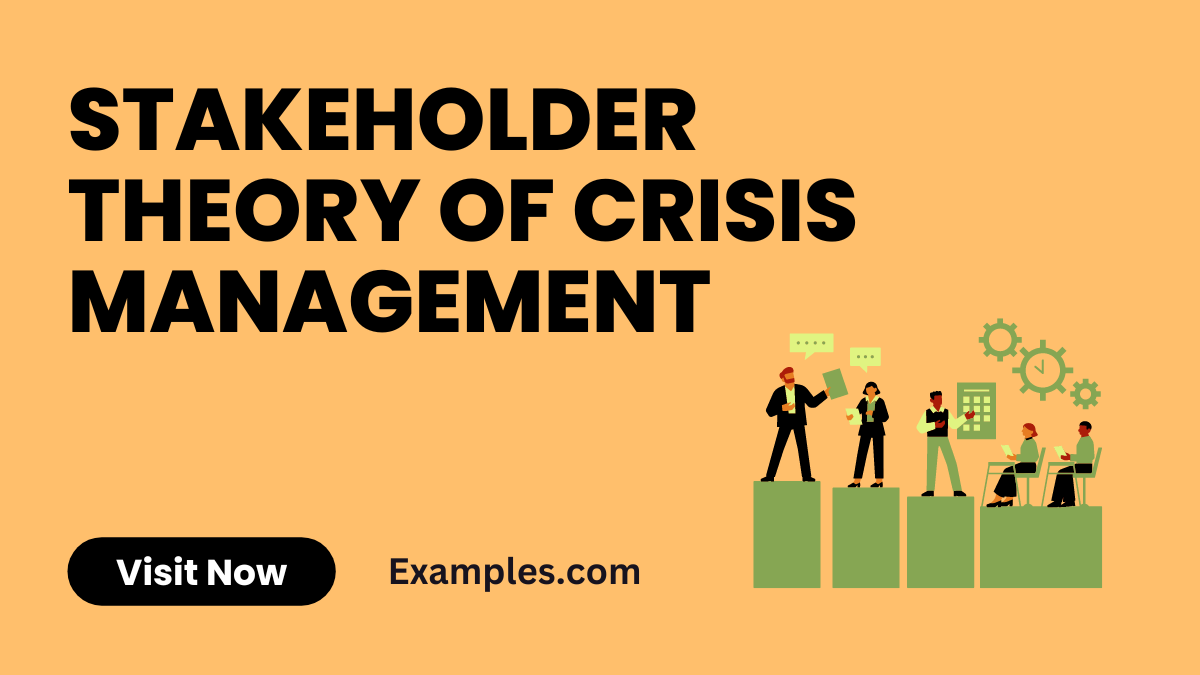19+ Stakeholder Theory of Crisis Management Examples
Unlock the power of Stakeholder Theory in Crisis Management with our comprehensive guide. Navigate turbulent times with strategic communication examples, equipping you to build robust relationships with stakeholders. Delve into practical applications and tips to harness the potential of this theory, ensuring effective crisis response. Elevate your crisis management skills as we explore the role of communication in Stakeholder Theory, offering valuable insights for mastering the art of navigating challenges while fostering stakeholder trust and collaboration.
What is Stakeholder Theory of Crisis Management?

Stakeholder Theory of Crisis Management is a strategic approach guiding organizations in crisis response. It emphasizes identifying and prioritizing stakeholders, recognizing their interests, and fostering open communication during crises. This theory asserts that successful crisis management hinges on building positive relationships with stakeholders, considering their perspectives, and aligning actions with shared interests. By recognizing the critical role of stakeholders in crisis situations, organizations can navigate challenges effectively and cultivate resilience through transparent and strategic communication.
20 Stakeholder Theory of Crisis Management Examples

Embrace the Stakeholder Theory of Crisis Management with these examples, showcasing effective communication strategies in turbulent times. From engaging stakeholders to addressing concerns, these instances illuminate the theory’s application.
- Media Collaboration: In a crisis, collaborate with media to disseminate accurate information, fostering transparency and credibility.
- Employee Support Programs: Launch programs providing emotional and practical support to employees during crises, reinforcing organizational commitment.
- Community Partnership Outreach: Foster community partnerships, demonstrating shared values and mutual support in times of adversity.
- Regular Stakeholder Updates: Keep stakeholders informed through regular updates, ensuring transparency and addressing concerns promptly.
- Proactive Social Media Communication: Leverage social media for proactive crisis communication, addressing issues directly and managing the narrative effectively.
- Customer Feedback Integration: Actively seek and integrate customer feedback into crisis resolution, showcasing responsiveness and commitment to improvement.
- Cross-Functional Crisis Teams: Form cross-functional teams involving various departments for comprehensive crisis management and cohesive communication.
- Ethical Decision-Making Communication: Communicate ethical decision-making processes, reinforcing the organization’s commitment to moral principles during crises.
- Environmental Impact Mitigation: Communicate proactive measures to mitigate environmental impacts, addressing concerns and showcasing responsible crisis management.
- Product Recall Transparency: Transparently communicate product recalls, detailing the reasons, risks, and corrective actions taken, fostering consumer trust.
- Government Relations Collaboration: Collaborate with regulatory bodies during crises, demonstrating commitment to compliance and effective crisis resolution.
- Crisis Simulation Exercises: Conduct crisis simulation exercises, preparing the organization for effective communication and response in real crises.
- Financial Impact Disclosure: Disclose the financial impact of crises honestly, providing stakeholders with a clear understanding of the situation.
- Interactive Crisis Communication Platforms: Utilize interactive platforms for crisis communication, encouraging stakeholder engagement and understanding.
- Employee Training Programs: Implement training programs to equip employees with crisis communication skills, ensuring a cohesive organizational response.
- Supplier Accountability Communication: Hold suppliers accountable for their role in crises, communicating corrective actions and preventive measures.
- Strategic Collaboration Announcements: Announce collaborations strategically, emphasizing shared goals and reinforcing a collaborative approach to crisis resolution.
- Diversity and Inclusion Initiatives: Communicate diversity and inclusion initiatives during crises, showcasing an inclusive organizational culture.
- Health and Safety Violation Response: Communicate immediate corrective actions in response to health and safety violations, ensuring stakeholder confidence.
- Crisis Impact Reports: Release comprehensive impact reports after crises, outlining lessons learned and steps taken for continuous improvement.
Stakeholder Theory of Crisis Management Examples in Business
Effectively applying the Stakeholder Theory of Crisis Management in business involves strategic communication to maintain trust. Learn from diverse examples illustrating the theory’s adaptability and success in the corporate landscape.
- Transparent Financial Communication: Transparently communicate financial challenges during crises, ensuring stakeholders understand the impact and the organization’s commitment to recovery.
- Executive Leadership Engagement: Engage executives directly with stakeholders during crises, showcasing leadership involvement and commitment to navigating challenges collectively.
- Brand Reputation Restoration: Restore brand reputation by acknowledging shortcomings, implementing corrective actions, and transparently communicating the commitment to improvement.
- Supply Chain Resilience Communication: During supply chain disruptions, communicate resilience strategies, ensuring stakeholders understand proactive measures and the commitment to stable operations.
- Innovative Product Crisis Resolution: Innovatively resolve product-related crises by communicating unique solutions, emphasizing organizational adaptability, and reinforcing commitment to customer safety.
Stakeholder Theory of Crisis Management Examples for Students
For students learning crisis communication, the Stakeholder Theory offers valuable insights. Explore examples tailored to educational settings, illustrating effective communication strategies and the theory’s application.
- Campus Safety Communication: In campus crises, communicate safety measures transparently, ensuring students understand the protocols and fostering a sense of security.
- Student-Faculty Collaboration: Encourage collaboration between students and faculty during crises, fostering an inclusive approach to crisis management and effective communication channels.
- Emergency Response Simulations: Conduct emergency response simulations for students, providing hands-on experience in crisis communication and preparedness.
- Interactive Crisis Workshops: Host interactive crisis workshops, allowing students to actively engage in crisis communication scenarios, enhancing practical skills and understanding.
- Diversity and Inclusion Initiatives Communication: Communicate diversity and inclusion initiatives during crises, showcasing an inclusive organizational culture that students can learn and emulate.
What is the Role of Stakeholder Theory of Crisis Management?

The Stakeholder Theory of Crisis Management plays a crucial role in navigating organizational challenges. Understanding its role involves recognizing key aspects:
1. Identifying Key Stakeholders: Recognize and analyze key stakeholders who can influence or are influenced by the organization during a crisis.
2. Understanding Stakeholder Interests: Assess the interests, concerns, and expectations of identified stakeholders to tailor crisis communication strategies effectively.
3. Communication Alignment: Align communication efforts with stakeholder needs, fostering transparency and building trust during challenging situations.
4. Proactive Stakeholder Engagement: Proactively engage with stakeholders, involving them in the crisis management process to gain insights and maintain open communication channels.
5. Mitigating Negative Impacts: Employ strategies to minimize negative impacts on stakeholders, demonstrating a commitment to their well-being and concerns.
What is the Approach of Stakeholder Theory of Crisis Management?
Understanding the approach of the Stakeholder Theory involves delving into specific methodologies and principles:
1. Holistic Crisis Assessment: Conduct a comprehensive assessment of the crisis, considering its potential impacts on various stakeholders and the broader organizational context.
2. Prioritizing Stakeholder Needs: Prioritize stakeholder needs based on the severity and urgency of their concerns, ensuring a focused and strategic response.
3. Tailoring Communication Strategies: Customize communication strategies for different stakeholder groups, acknowledging their unique needs and preferred channels of communication.
4. Collaborative Decision-Making: Embrace collaborative decision-making involving stakeholders, fostering a sense of shared responsibility and collective problem-solving.
5. Adaptive Communication: Adapt communication approaches based on the evolving nature of the crisis, ensuring flexibility in addressing emerging challenges.
How Important is Stakeholder Theory of Crisis Management?
The significance of the Stakeholder Theory in crisis management is underscored by several critical factors:
1. Trust Building and Preservation: Establish and preserve trust with stakeholders, a critical asset during crises, by demonstrating openness, responsiveness, and commitment to their concerns.
2. Reputation Management: Safeguard organizational reputation by actively addressing stakeholder concerns and communicating effective crisis management strategies.
3. Enhanced Organizational Resilience: Contribute to organizational resilience by integrating stakeholder perspectives, insights, and collaboration into crisis management practices.
4. Sustainable Relationship Development: Build sustainable relationships with stakeholders through transparent and ethical crisis communication, fostering long-term organizational support.
5. Minimizing Negative Consequences: Minimize negative consequences of a crisis by strategically involving stakeholders, mitigating potential backlash, and ensuring a more positive outcome.
In conclusion, the Stakeholder Theory of Crisis Management serves as a guiding framework for organizations navigating challenging situations. By prioritizing stakeholder engagement, tailoring communication strategies, and embracing a collaborative approach, organizations can effectively manage crises, preserve trust, and build resilient relationships. The incorporation of real-world examples enriches understanding, making this guide a valuable resource for navigating the complexities of crisis management with stakeholder interests at the forefront.
19+ Stakeholder Theory of Crisis Management Examples

Unlock the power of Stakeholder Theory in Crisis Management with our comprehensive guide. Navigate turbulent times with strategic communication examples, equipping you to build robust relationships with stakeholders. Delve into practical applications and tips to harness the potential of this theory, ensuring effective crisis response. Elevate your crisis management skills as we explore the role of communication in Stakeholder Theory, offering valuable insights for mastering the art of navigating challenges while fostering stakeholder trust and collaboration.
What is Stakeholder Theory of Crisis Management?

Stakeholder Theory of Crisis Management is a strategic approach guiding organizations in crisis response. It emphasizes identifying and prioritizing stakeholders, recognizing their interests, and fostering open communication during crises. This theory asserts that successful crisis management hinges on building positive relationships with stakeholders, considering their perspectives, and aligning actions with shared interests. By recognizing the critical role of stakeholders in crisis situations, organizations can navigate challenges effectively and cultivate resilience through transparent and strategic communication.
20 Stakeholder Theory of Crisis Management Examples

Embrace the Stakeholder Theory of Crisis Management with these examples, showcasing effective communication strategies in turbulent times. From engaging stakeholders to addressing concerns, these instances illuminate the theory’s application.
Media Collaboration: In a crisis, collaborate with media to disseminate accurate information, fostering transparency and credibility.
Employee Support Programs: Launch programs providing emotional and practical support to employees during crises, reinforcing organizational commitment.
Community Partnership Outreach: Foster community partnerships, demonstrating shared values and mutual support in times of adversity.
Regular Stakeholder Updates: Keep stakeholders informed through regular updates, ensuring transparency and addressing concerns promptly.
Proactive Social Media Communication: Leverage social media for proactive crisis communication, addressing issues directly and managing the narrative effectively.
Customer Feedback Integration: Actively seek and integrate customer feedback into crisis resolution, showcasing responsiveness and commitment to improvement.
Cross-Functional Crisis Teams: Form cross-functional teams involving various departments for comprehensive crisis management and cohesive communication.
Ethical Decision-Making Communication: Communicate ethical decision-making processes, reinforcing the organization’s commitment to moral principles during crises.
Environmental Impact Mitigation: Communicate proactive measures to mitigate environmental impacts, addressing concerns and showcasing responsible crisis management.
Product Recall Transparency: Transparently communicate product recalls, detailing the reasons, risks, and corrective actions taken, fostering consumer trust.
Government Relations Collaboration: Collaborate with regulatory bodies during crises, demonstrating commitment to compliance and effective crisis resolution.
Crisis Simulation Exercises: Conduct crisis simulation exercises, preparing the organization for effective communication and response in real crises.
Financial Impact Disclosure: Disclose the financial impact of crises honestly, providing stakeholders with a clear understanding of the situation.
Interactive Crisis Communication Platforms: Utilize interactive platforms for crisis communication, encouraging stakeholder engagement and understanding.
Employee Training Programs: Implement training programs to equip employees with crisis communication skills, ensuring a cohesive organizational response.
Supplier Accountability Communication: Hold suppliers accountable for their role in crises, communicating corrective actions and preventive measures.
Strategic Collaboration Announcements: Announce collaborations strategically, emphasizing shared goals and reinforcing a collaborative approach to crisis resolution.
Diversity and Inclusion Initiatives: Communicate diversity and inclusion initiatives during crises, showcasing an inclusive organizational culture.
Health and Safety Violation Response: Communicate immediate corrective actions in response to health and safety violations, ensuring stakeholder confidence.
Crisis Impact Reports: Release comprehensive impact reports after crises, outlining lessons learned and steps taken for continuous improvement.
Stakeholder Theory of Crisis Management Examples in Business
Effectively applying the Stakeholder Theory of Crisis Management in business involves strategic communication to maintain trust. Learn from diverse examples illustrating the theory’s adaptability and success in the corporate landscape.
Transparent Financial Communication: Transparently communicate financial challenges during crises, ensuring stakeholders understand the impact and the organization’s commitment to recovery.
Executive Leadership Engagement: Engage executives directly with stakeholders during crises, showcasing leadership involvement and commitment to navigating challenges collectively.
Brand Reputation Restoration: Restore brand reputation by acknowledging shortcomings, implementing corrective actions, and transparently communicating the commitment to improvement.
Supply Chain Resilience Communication: During supply chain disruptions, communicate resilience strategies, ensuring stakeholders understand proactive measures and the commitment to stable operations.
Innovative Product Crisis Resolution: Innovatively resolve product-related crises by communicating unique solutions, emphasizing organizational adaptability, and reinforcing commitment to customer safety.
Stakeholder Theory of Crisis Management Examples for Students
For students learning crisis communication, the Stakeholder Theory offers valuable insights. Explore examples tailored to educational settings, illustrating effective communication strategies and the theory’s application.
Campus Safety Communication: In campus crises, communicate safety measures transparently, ensuring students understand the protocols and fostering a sense of security.
Student-Faculty Collaboration: Encourage collaboration between students and faculty during crises, fostering an inclusive approach to crisis management and effective communication channels.
Emergency Response Simulations: Conduct emergency response simulations for students, providing hands-on experience in crisis communication and preparedness.
Interactive Crisis Workshops: Host interactive crisis workshops, allowing students to actively engage in crisis communication scenarios, enhancing practical skills and understanding.
Diversity and Inclusion Initiatives Communication: Communicate diversity and inclusion initiatives during crises, showcasing an inclusive organizational culture that students can learn and emulate.
What is the Role of Stakeholder Theory of Crisis Management?

The Stakeholder Theory of Crisis Management plays a crucial role in navigating organizational challenges. Understanding its role involves recognizing key aspects:
1. Identifying Key Stakeholders: Recognize and analyze key stakeholders who can influence or are influenced by the organization during a crisis.
2. Understanding Stakeholder Interests: Assess the interests, concerns, and expectations of identified stakeholders to tailor crisis communication strategies effectively.
3. Communication Alignment: Align communication efforts with stakeholder needs, fostering transparency and building trust during challenging situations.
4. Proactive Stakeholder Engagement: Proactively engage with stakeholders, involving them in the crisis management process to gain insights and maintain open communication channels.
5. Mitigating Negative Impacts: Employ strategies to minimize negative impacts on stakeholders, demonstrating a commitment to their well-being and concerns.
What is the Approach of Stakeholder Theory of Crisis Management?
Understanding the approach of the Stakeholder Theory involves delving into specific methodologies and principles:
1. Holistic Crisis Assessment: Conduct a comprehensive assessment of the crisis, considering its potential impacts on various stakeholders and the broader organizational context.
2. Prioritizing Stakeholder Needs: Prioritize stakeholder needs based on the severity and urgency of their concerns, ensuring a focused and strategic response.
3. Tailoring Communication Strategies: Customize communication strategies for different stakeholder groups, acknowledging their unique needs and preferred channels of communication.
4. Collaborative Decision-Making: Embrace collaborative decision-making involving stakeholders, fostering a sense of shared responsibility and collective problem-solving.
5. Adaptive Communication: Adapt communication approaches based on the evolving nature of the crisis, ensuring flexibility in addressing emerging challenges.
How Important is Stakeholder Theory of Crisis Management?
The significance of the Stakeholder Theory in crisis management is underscored by several critical factors:
1. Trust Building and Preservation: Establish and preserve trust with stakeholders, a critical asset during crises, by demonstrating openness, responsiveness, and commitment to their concerns.
2. Reputation Management: Safeguard organizational reputation by actively addressing stakeholder concerns and communicating effective crisis management strategies.
3. Enhanced Organizational Resilience: Contribute to organizational resilience by integrating stakeholder perspectives, insights, and collaboration into crisis management practices.
4. Sustainable Relationship Development: Build sustainable relationships with stakeholders through transparent and ethical crisis communication, fostering long-term organizational support.
5. Minimizing Negative Consequences: Minimize negative consequences of a crisis by strategically involving stakeholders, mitigating potential backlash, and ensuring a more positive outcome.
In conclusion, the Stakeholder Theory of Crisis Management serves as a guiding framework for organizations navigating challenging situations. By prioritizing stakeholder engagement, tailoring communication strategies, and embracing a collaborative approach, organizations can effectively manage crises, preserve trust, and build resilient relationships. The incorporation of real-world examples enriches understanding, making this guide a valuable resource for navigating the complexities of crisis management with stakeholder interests at the forefront.


